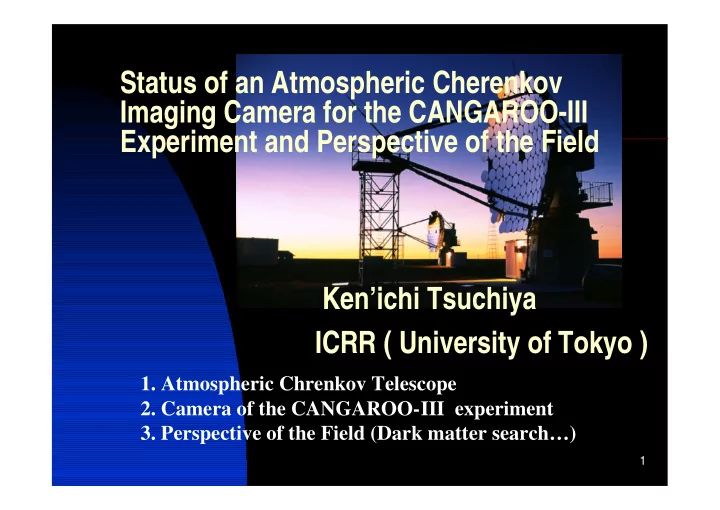

Status of an Atmospheric Cherenkov Imaging Camera for the CANGAROO-III Experiment and Perspective of the Field Ken’ichi Tsuchiya ICRR ( University of Tokyo ) 1. Atmospheric Chrenkov Telescope 2. Camera of the CANGAROO-III experiment 3. Perspective of the Field (Dark matter search…) 1
CANGAROO Collaboration of Australia and Nippon(Japan) for a GAmma-Ray Observatory in the Outback Very high energy gamma-rays Cherenkov light Outback = Desert for the observations in the dark site Southern hemisphere � galactic objects 2
The Techniques of High energy gamma-ray astronomy 10km � 100GeV - 10TeV gamma-ray � Large acceptance ( 10 9 cm 2 ) Satellite IACT (Imaging Atmospheric Cherenkov Telescope ) (EGRET) 100GeV -10TeV Energy 100MeV-10GeV 10 3 cm 2 10 9 cm 2 Acceptance 3 - 4 F.O.V 30 degree degree 3
Imaging analysis Shower developments gamma proton 1TeV Gamma-ray Proton Gamma-ray : proton = 1:1000 20km Length Width Fine pixel camera 10km alpha I mage centroid Wide field of view Distance I mage axis Target center Focal plane camera images 99.7% rejection 4
The history of CANGAROO � Large mirror � low energy threshold � Large field of view and fine pixel 7m � 10m 3.8m 1999- 1992-1998 CANGAROO-I CANGAROO-II 3 degree 3 degree 256 PMTs 552 PMTs 0.12 degree 5
CANGAROO-III Focal plane camera image : stereoscopic observation � Better angular resolution 0.2 degree � 0.05 degree � Better energy resolution 30% � 15% 100 m Cherenkov light pool � 125 m radius 6
CANGAROO-III Camera � Large Field of view 3 � 4 degree � 427x0.17 ° pixels with light guides � Controlled High Voltage to each PMT � Low noise � Large dynamic range with good linearity Photo Multiplier Tube(PMT) CANGAROO-II Kabuki et al. N.I.M. A500 318-336 (2003) CANGAROO-III 7
Real data Photons of Cherenkov light � Shower energy TDC ADC good timing resolution ~ 1ns Bright star in the field of view PMT current Cut down high voltage 8
Accelerators in the universe Very High highly accelerated protons + matters Energy electrons + photons Gamma-rays exotic origin ? SNR RX J1713.7-3946 Supernova Remnant (SNR) Tanimori et al. Enomoto et al. ApJ 497 Nature 416 L25(1998) 823-826(2002) The origin of cosmic-ray? NGC253 Itoh et al. ApJL 584 L65-L68 (2002) SN1006 (TeV gamma-ray, X-ray) 9
What should we select as the target? � “Known” objects: SNRs, pulsars, Active Galactic Nuclei… � New type objects � starburst galaxies, molecular clouds Massive black hole The Galactic Center Supernova remnant Dark matter?? CANGAROO-III F.O.V. VLA radio continuum image (6cm) EGRET detected Gamma -rays from the galactic center. (100MeV-10GeV) Radio image (90cm) 10
Dark matter search – Galactic Center ρ − ∝ σ 2 Concentration of Cold Dark Matter gamma rayFlux ( ) v � M toward the Galactic Center χ MSSM (Minimal super symmetric model) � χχ → γ Neutralino annihilations � 2 Enhanced density at the CANGAROO-III Galactic Center Sensitivity Gamma-ray energy Gondolo&Silk Bergstrom et al Phy.Rev.Let, 83(1999) Astroparticle Phys. 11 1719-1722 (1997)
Galactic Center observations with CANGAROO-II telescope Alpha distributions � Observation data On-source 2001 2001 July (20.3 hours) 2002 July, August (50.3 hours) OFF-source � preliminary result Preliminary! � 2002 data is under analysis These excess events indicate gamma-rays from Subtracted the galactic center events (E > 400GeV) Alpha Tsuchiya et al. 28 th ICRC (2003) 12
Summary � CANGAROO-III camera works well and will start stereoscopic observations with four telescopes in 2004. � We search the origin of cosmic-ray with the observation of SNR,pulsar,AGN … � IACT is one of the Dark matter search 13
CANGAROO collaboration Ibaraki University University of Adelaide Institute for Cosmic Ray Research, University of Tokyo Mt Stromlo and Siding Spring Observatories, Institute of Space and Astronautical Science Australian National University National Astronomical Observatory of Japan Tokai University Tokyo Institute of Technology Kyoto University Solar-Terrestrial Environmental Laboratory, Nagoya University Yamagata University Yamanashi Gakuin University Osaka City University Konan University Ibaraki Prefectural University of Health Sciences Shinshu University Kitasato University 14
Recommend
More recommend